Art Fairs
10 Out-of-This-World Installations at the 2018 SPRING/BREAK Art Show
From giant foam Cheetos to computer-powered weavings, the show's "Stranger Comes to Town" theme delivers some interesting results.
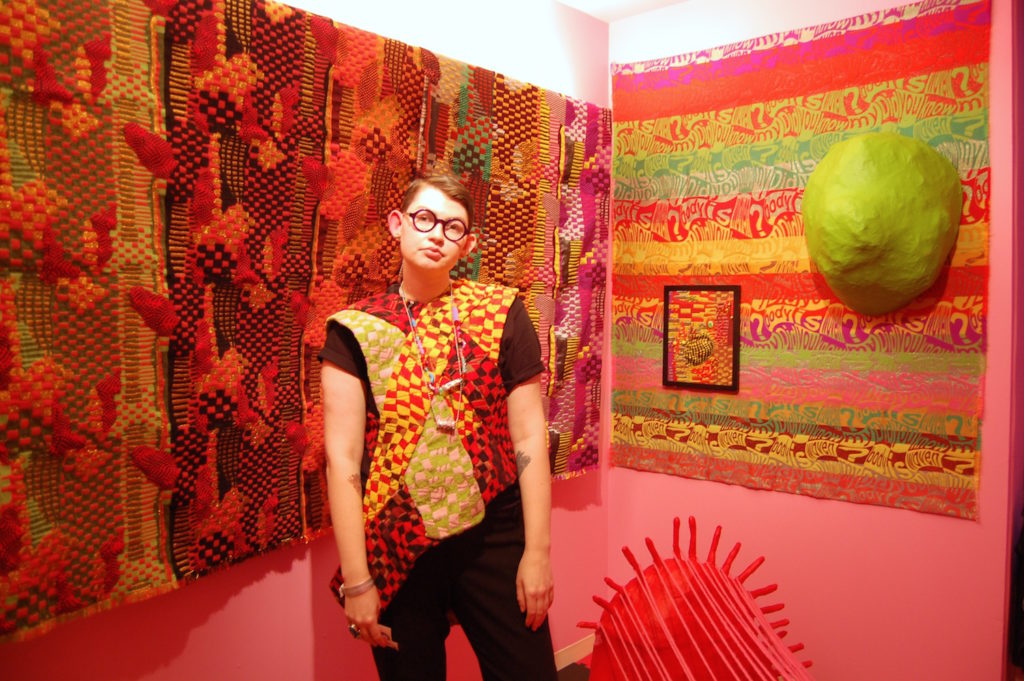
From giant foam Cheetos to computer-powered weavings, the show's "Stranger Comes to Town" theme delivers some interesting results.

Sarah Cascone

“Have you seen the crazy Cheetos?”, Andrew Gori asked artnet News during the VIP preview of the SPRING/BREAK Art Show, the fair he co-founded in 2012 with his now-wife Ambre Kelly. We were walking through the fair, on the hunt for its craziest installations, and it was hard to miss the Cheetos: foam sculptures, some over six feet in height, carefully wrapped in crushed orange velvet.
The fair, which features a unique model in which curators, not galleries, organize each booth, can get quite political—understandable given this year’s theme, “Stranger Comes to Town.” It’s inspired in no small part by the current debate over immigration and concerns about migration and xenophobia.

One of Andy Harman’s Cheeto sculptures at SPRING/BREAK Art Show. Photo courtesy of Sarah Cascone.
Don’t mistake the Cheetos for a critique of our famously orange president, however.
“That is a really unfortunate collision with my work,” artist Andy Harman told artnet News, explaining that the crunchy-looking sculptures, selected for the fair by Liz Collins, were about playing up the banality of everyday objects by enlarging them to repellant scale. “I never intended to address that man.”
SPRING/BREAK is also known for its unconventional venues, setting up shop in dormant spaces. For the second year in a row, that meant a perch high above Times Square, on the 22nd and 23rd floors of the former Condé Nast building. There, the art spills out of cubicles and other unconventional exhibition spaces.
Here are nine more must-see installations at the fair.
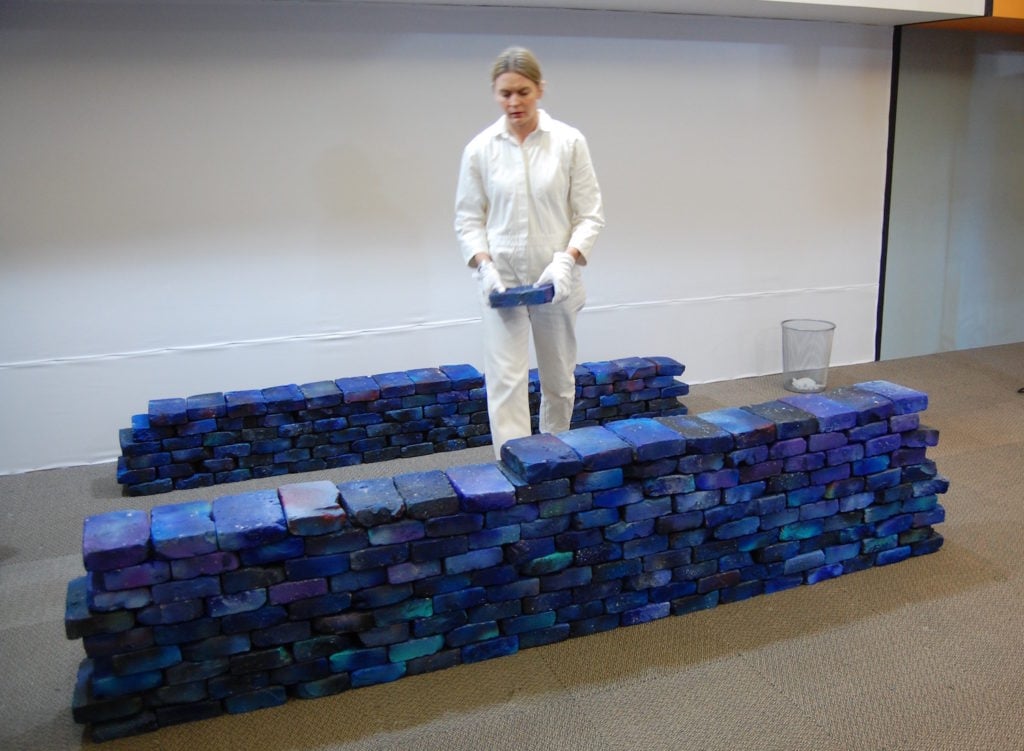
Anne Nowak, The Cosmic Wall at SPRING/BREAK Art Show. Photo courtesy of Sarah Cascone.
Twice a day, Danish artist Anne Nowak will stage an hour-long performance, breaking down a wall, brick by brick, and rebuilding it only a few feet away, only to move it back again. The sculpture, titled, The Cosmic Wall, is made of 250 blue bricks in all.
“It was inspired by the stupidity of using a wall to build a shield,” curator Henriette Noermark told artnet News, noting that growing up in Denmark in the 1980s, the Berlin Wall had loomed large for the artist as a symbol.
The piece is available for sale in its entirety, or as individual bricks, priced at $400 each, with the hope that the wall, and its accompanying Sisyphean task, will become smaller and more manageable during the course of the exhibition.

Elektra KB, Power Is Abuse at SPRING/BREAK Art Show. Photo courtesy of Sarah Cascone.
Just beyond Nowak’s wall, visitors run into what Gori called a “checkpoint Charlie,” a gatepost manned by Ukrainian-born Colombian artist Elektra KB. She serves as a government official for the Cathara Autonomous Territory, issuing passports that declare the bearer stateless.
“You abandon your alliance to: nation borders and gender borders, chauvinism, patriotism, and fascism,” reads the folded pink document, which is marked with your fingerprint and stamped by the artist. She stayed in character and refused to answer questions about the piece, which deals with notions of power and authority, and the effect that government has on our freedom and autonomy.
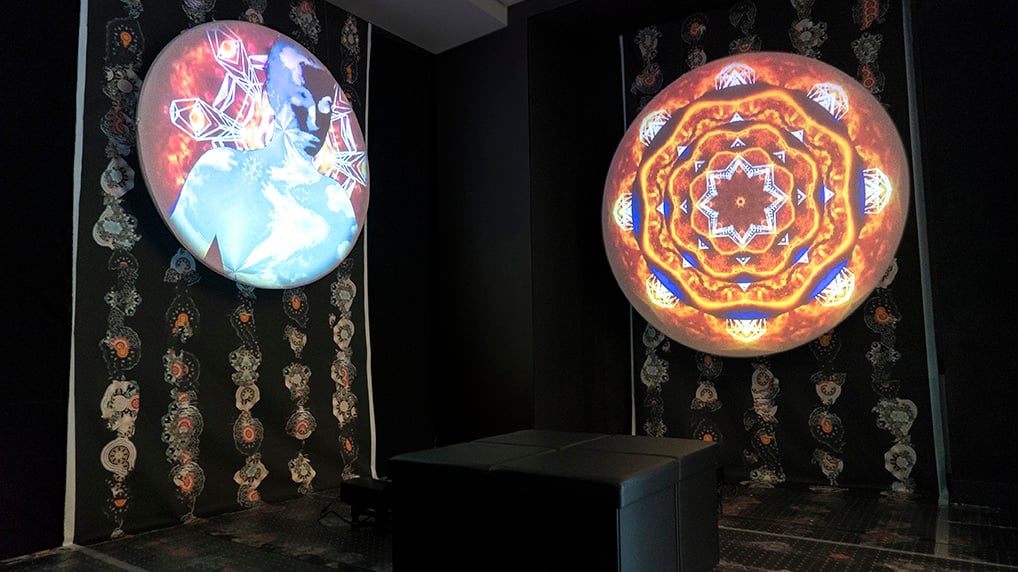
Anne Spalter, Meet Me in the Sun at SPRING/BREAK 2018. Courtesy of the artist.
Digital mixed-media artist Anne Spalter took a decidedly more optimistic view of the “Stranger Comes to Town” theme, choosing to focus instead on what humankind has in common, rather than the issues that divide us.
She’s paired footage of the sun from NASA with video of booth curator—and well-known artists’ muse—Natalie White, as well as beachgoers on the Caribbean island of Martinique. Frolicking in the heat, the backlit figures are reduced to silhouettes, their race indeterminable. “It’s about how everyone is together and equal under the sun,” Spalter told artnet News. “The sun is such a powerful, life-giving force.”
It’s her first piece that includes human figures, rather than just landscape footage. Still, it features the artist’s signature kaleidoscopic imagery. White, who is making her curatorial debut with the project, described it as a contrast to the loud spectacle that can define much of SPRING/BREAK, saying “there’s something really quiet and meditative about this room. People get lost in it.”
For Justin Wood, the stranger that came to town was Hurricane Irma, last September. “It really devastated a small portion of the Florida Keys, which is my immediate world,” the artist told artnet News.
His installation is made up of debris from the storm, which was piled 20 feet high on every block during the aftermath. An eerie light show plays across the sculptural mass—made up of broken shudders, lost business signs, and defunct satellite dishes, as well as LED screen paintings. Projection mapping highlights the outline of each object.
“The technique came from doing visuals for bands and DJs,” Wood explained. “The video has a narrative: from the evacuation and the uncertainty, to the storm and then the return and recovery.”
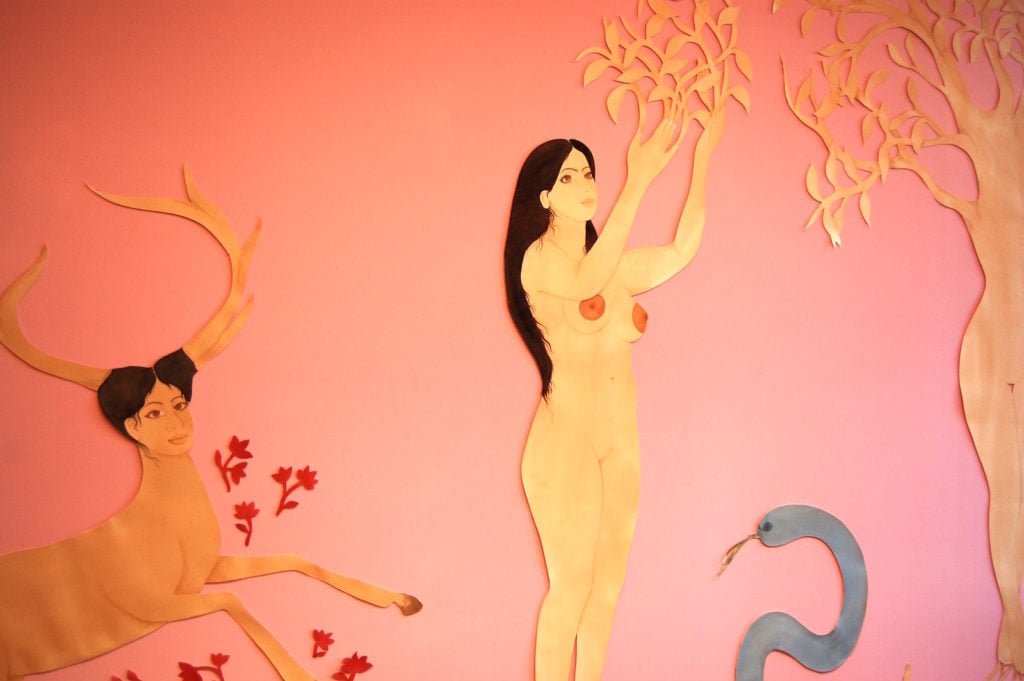
Installation view of Hiba Schahbaz, The Garden, curated by Field Projects at SPRING/BREAK Art Show 2018. Photo courtesy of Sarah Cascone.
Hiba Schahbaz expands upon her work inspired by traditional Indo-Persian miniature painting by transforming her room at SPRING/BREAK into an art historical fairy tale, strong female figures floating on pale pink walls.
“It’s my first installation of painted cut-outs,” she told artnet News. “Usually I do life-size mural pieces. I wanted to create something beautiful, female-centric, and a little bit light.”
Schahbaz paints her figures’s skin using black tea from Pakistan, but has loaded the work with images from Western art history, such as Frida Kahlo’s The Wounded Deer and Gian Lorenzo Bernini’s Apollo and Daphne, straddling two different cultural traditions.
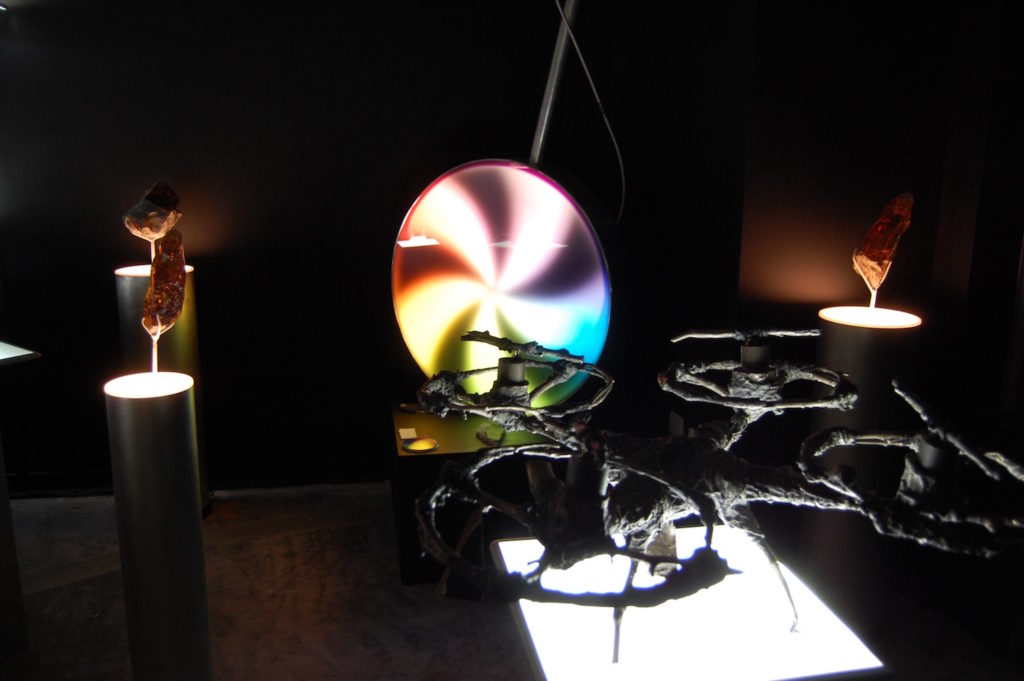
Evan Yee, The Museum From the Future, at SPRING/BREAK Art Show. Photo courtesy of Sarah Cascone.
Evan Yee fancies himself an archaeologist, imagining a future where today’s most advanced technologies are ancient ruins, frozen in amber.
In addition to batteries and other objects encased in resin, Yee has created a kind of urn, illuminated sculptures of hands holding aluminum iPhone-shaped hourglasses filled with the ground-up remains of smartphones. “I got really sick after blending them the first time,” Yee admitted, noting that the works are not just a commentary about how much time we spend on our phones, but an examination of how “we are immortalizing our selves on these devices.”
Though at first glance the work appears to offer a critique of our plugged-in society’s reliance on the internet and social media, the artist’s intent is more complicated than that. “I use all these devices, I’m definitely a Millennial,” Yee admitted. “I want to question how our digital age is going to effect our future. We have this drive to make the things that we use last forever, but it will all be gone blink of an eye, geologically speaking.”
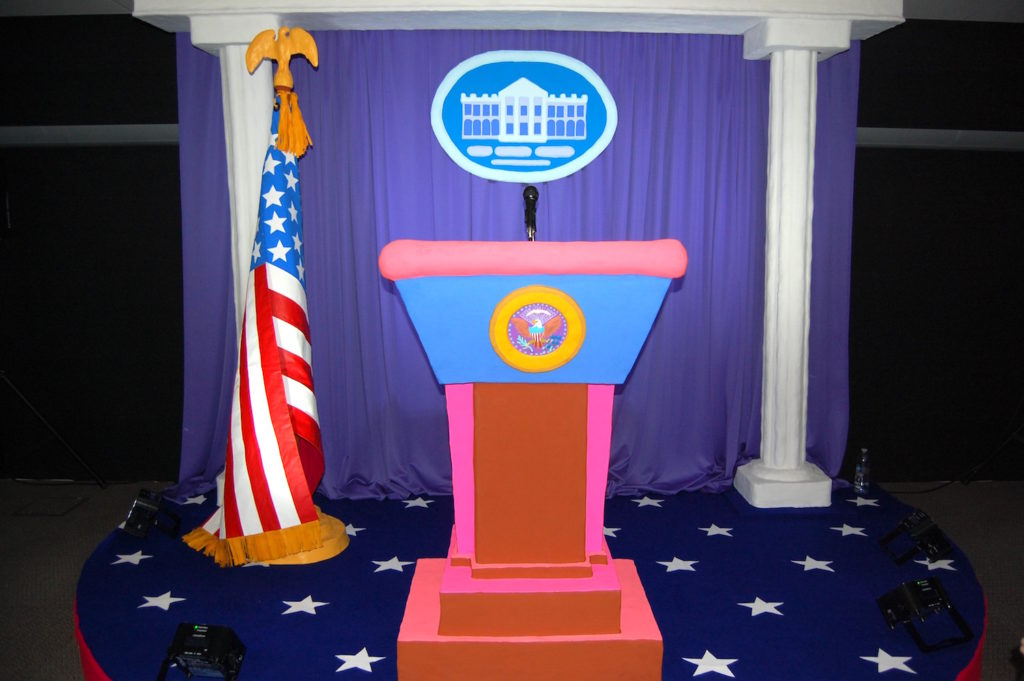
Macon Reed, A Pressing Conference, at SPRING/BREAK Art Show. Photo courtesy of Sarah Cascone.
“Good afternoon ladies and gentlemen. We want more transparency,” announced an official from the city’s department of buildings, standing at a brightly colored podium, modeled after the White House press briefing room. Tasked with inspecting the fair, he’d been convinced to speak out about what the government could be doing better as part of Macon Reed’s participatory project, A Pressing Conference.
It’s exactly what the artist wanted. The work is designed to give a platform to people who otherwise might not have one. “I want to bring in community outside the arts,” Reed told artnet News. There will be twice-daily performances from history teachers, activists, journalists, and others offering instructions on how to resist the rise of authoritarian governments.
The podium faces an invisible press corps, each chair labeled with the name of a journalist who has faced governmental opposition, from harassment by Trump to writers who have been imprisoned or even killed for their work. “There are very different levels of mistreatment,” said Reed. “My hope is that people will Google these names.”
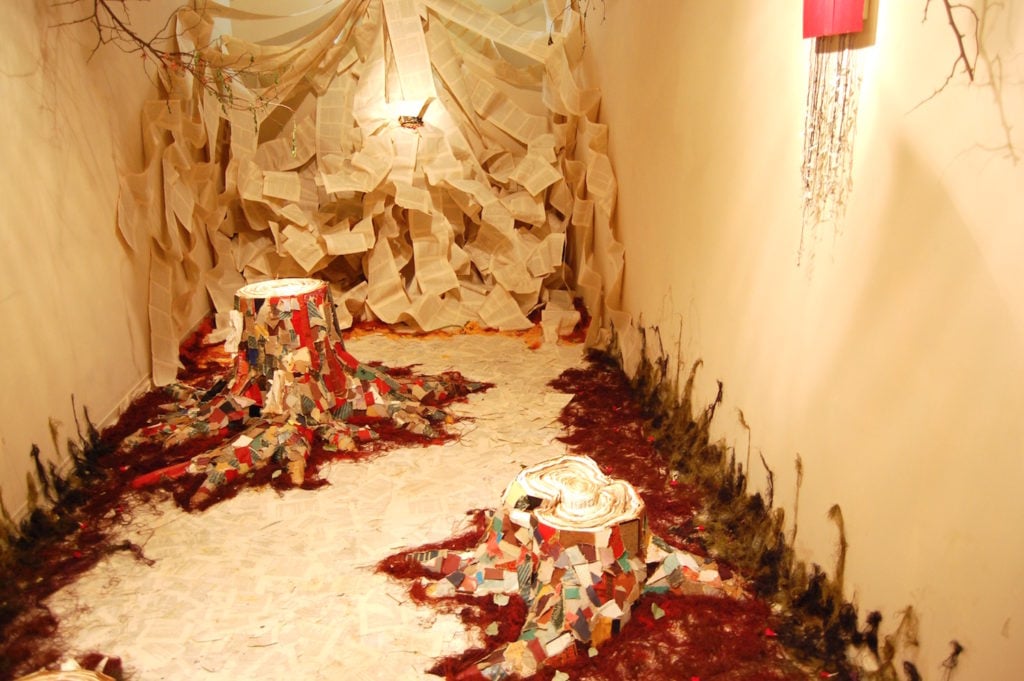
Rachel Marks, The Poetry of Earth, at SPRING/BREAK Art Show. Photo courtesy of Sarah Cascone.
“I kind of think of myself as a scientist,” Rachel Marks told artnet News. Wearing a flower crown, standing amid her forest-like installation, crafted from the pages, bindings, and covers of countless books, she looked more like a fairy, magically bringing some kind of literary fantasy to life.
“I like to look at the way a book is made: how it smells, what kind of paper it is, what the binding is made from. I like to dissect it like a living organism—which, in the end, it was,” she added.
Three paper tree stumps, surrounded by a mosslike growth of binding thread, allude to paper’s source material—”we’re in the library of the forest”—while the back wall featured an explosive piece made up of the pages of four encyclopedia volumes.
“It represents an ocean the biodiversity of our culture spilling out,” Marks explained.
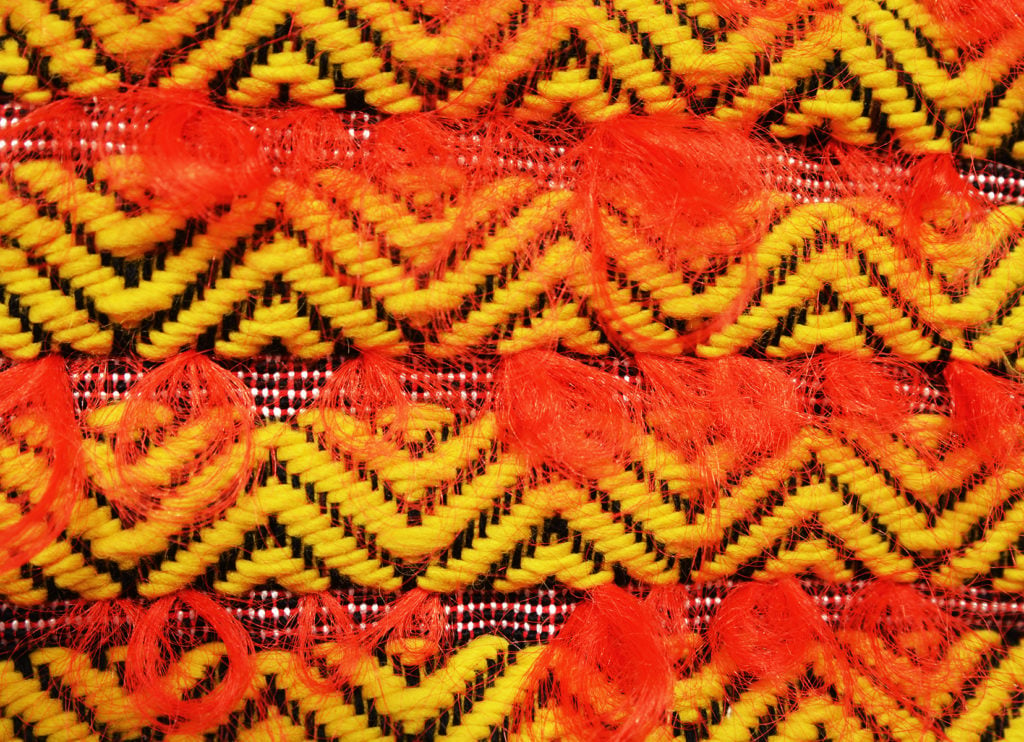
Detail of a woven work from Zoe Schlacter. Photo courtesy of the artist.
Zoe Schlacter blended right into her colorful installation wearing a woven top that perfectly matches her textile works, some handmade, and others produced by a computerized Jacquard loom. The latter works featured stunningly complex designs.
Her small room was covered from floor to ceiling with large, bulbous papier mache sculptures accompanying the fabric wall hangings.
“The premise of the installation is about weaving your own body,” the artist told artnet News. “It’s a sci-fi narrative about these, bodily, blobby sculpture as a means of overcoming gender anxiety and the limitations of having a human body.”
SPRING/BREAK Art Show “Stranger Comes to Town” is on view at 4 Times Square (entrance on West 43rd Street), New York, March 6–12, 2018. Tickets are $15.